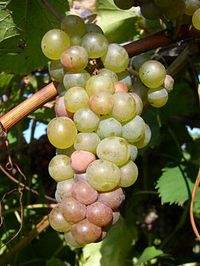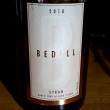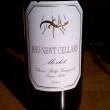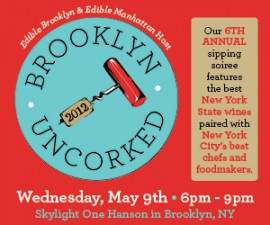Keuka Lake Vineyards: Hybrids Providing More Mileage In Dry Style
By Evan Dawson, Finger Lakes Editor
This is apparently a controversial or surprising thing to say, but I'll say it anyway — the writers and editors for this blog like hybrid wines from New York state. I have voluntarily purchased vignoles. I have consumed an entire bottle of Cayuga without convulsing. I do not believe that hybrids cause sterility, senility or loss of agility.
There is, however, plenty of room for hybrids to improve.
One way that some local wineries are trying to get more mileage from their hybrids is by going with a much dryer style. That's the plan at Keuka Lake Vineyards on southwestern Keuka Lake, where winemaker Staci Nugent makes a pair of hybrid wines: vignoles and Leon Millet.
"Customers tend to expect hybrid wines to be really sweet," Nugent told me on a gorgeous recent afternoon at the winery. "They're surprised with how dry these wines finish — especially the vignoles."
Keuka Lake Vineyards' vignoles brings 1.6 RS (residual sugar), and Nugent's right — it finishes very dry with an emphasis on the acidity instead of the classic, richly sweet vignoles character. In fact, this wine was buzzing so much I later wondered if the acidity had been manually adjusted; it was like putting your cell phone on vibrate, placing it in your mouth, and asking a friend to call you.
"Dry hybrids compare very favorably with dry vinifera wines," Nugent said. "They can show a lot of complexity and personality."
Vignoles is still most often sweeter when made in the Finger Lakes. Anthony Road Wine Company makes luscious dessert wines with the hideously ugly grape (pictured at right). Fulkerson Winery offers a 6.1 RS vignoles (labeled there as its alter ego, Ravat 51).
But other wineries are taking it much dryer. Ravines Wine Cellars makes a blend of vignoles and Cayuga called Keuka Village White that never sees more than 1.0 RS. The list of other dry hybrid wines is getting longer.
After I returned home from my trip to Keuka Lake Vineyards I found myself with several questions. Why does the winery call their inky black red hybrid "Leon Millet" when most others call it "Leon Millot?" Why is vignoles such a wretchedly vile-looking grape when it ripens (the clusters tend to look like multi-colored Rorschach tests, berries varying in size and hue) — but such a lovely wine in the glass?
I would Google the answers but I'm late for a doctor's appointment. I think I might have swallowed some Seyval last night.


















One of my favorite images is the crippled, caged pigeons Dr. Konstantin Frank kept at the winery, telling visitors their deformities were caused by consumption of hybrid grapes.
A fleck of truth, of course. High ethyl carbamate levels in hybrids were a concern. But research by NYSAES’s Don Splittstoesser ended those fears.
“Leon Millet” appears to be a spelling error, much like “Gewurtztraminer”, not exclusive to this fine winery.
I can claim to be the only person to have noticed a local winery happily selling one of their whites as “Seval Blanc” (sic).
Then there was the Rhone-style wine that debuted when I was living in Australia called Nine Popes, which the owner explained on the back label was the English term for Chateauneuf-du-Pape.
I must admit, I need an education in this area of hybrid grapes.
Save your time Michael, that’s like a Belgian brewmaster saying I need an education in the area of Natural Light.
Keep in mind that when you use the word “hybrid” that some so-called native American varieties are hybrids, too, although not by man, but by nature, and with vinifera in their bloodline: i.e. Catawba, Isabella…
It would be more informative to refer to hybrids either as French-American hybrid, Cornell (or other) University hybrid, field hybrid, et al.
I don’t know what all the fuss is about, really. You either like a wine or you don’t. Why should the grape’s parentage be of concern other than academic and to identify characteristics?
What am I missing?
Peter, the name Seyval Blanc was applied to separate the Seyve-Villard 5-276 from its many red and white counterpart Seyve-Villard hybrids.
Thomas, you wrote:
“I don’t know what all the fuss is about, really. You either like a wine or you don’t. Why should the grape’s parentage be of concern other than academic and to identify characteristics? What am I missing?”
Hybrids have a reputation for being sweet wines. Certainly, if you read comments like the one posted above by jim, hybrids have a reputation for being inferior wines. Surely this is not new to you. Thus, when a trend emerges showing more wineries making hybrids in dryer styles, it’s worth discussing. And in the context of the discussion about the NY Wine and Food Classic, it’s timely.
Evan,
I have no idea from where a reputation for French hybrids being sweet emanates.
The premise that Vignoles is sweet is correct, as most of them are produced that way-as well as many Vidals. The balancing act required to produce Vignoles in a dry style turns some winemakers off to the effort. The acids in that grape generally are formidable. But sweet Seyval isn’t a normal practice-they range from dry to semi-sweet. Same with others. I’ve been consuming dry versions of French-American and Cornell hybrids for 25 years, both whites and reds.
With all hybrids I have my likes and I have my dislikes, completely subjective. That is no measure of superiority or inferiority-it is a measure of aesthetics.
In the end, it’s all about preference. Like Jim, I think light beer is deplorable tasting stuff, but it’s not inferior to other beer-it’s just deplorable tasting stuff to Jim and to me. Since many people drink it, it can’t possibly be considered inferior by them. I may not agree or understand their choice, but I certainly don’t feel superior to them.
This superior/inferior thing is partly responsible for wine still being regarded in the U.S. as an elitist product.
I can understand why Evan might think acid was added to our Vignoles - it certainly has an amazing amount of natural acidity. The 2008 clocks in at 11.5 g/L. No acid adjustments needed! No sir-ee.
And with the Leon Millot, we spell it with the ‘ot’ as far as I’ve ever noticed. I just rushed out and checked our tasting room notes. They cleared. Not certain where the ‘et’ came from, perhaps a stray misspelled reference.
Cheers, Staci
Staci,
We’ve really enjoyed pouring that Vignoles for friends. Very nicely done. Even in tasting Anthony Road’s Vignoles TBA next to the Riesling TBA, it’s clear how much natural acidity Vignoles has. I hope my rather flippant remark didn’t offend you.
Thanks for clearing up the Millot mystery. Must have seen a tasting sheet misprint. Very inky wine; probably needs its own post in the future. Cheers!